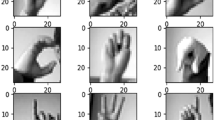Abstract
The American Gesture based communication (ASL) is expressively helped for hard of hearing correspondence. Slowly gesture based communication use for the correspondence among open and the hard of hearing network. In this proposed framework another model of ASL letters in order and numerals are utilized to effectively recognize. It comprises of train hybrid classifier and 4 stages they are Pre-processing, segmentation, feature extraction and classification. The train hybrid classifier comprises of 35 letter sets and number which is familiar to gathering intensity information onto numerous subjects. This exertion connected with existing classifier, for example, CNN and ANN classifier. The execution of proposed work is estimated about precision, specificity and sensitivity on test result. It will help to, diminishes the false positive rates and accomplishes a decent accuracy yield.





Similar content being viewed by others
References
Chai X, Li G, Lin Y, Xu Z, Tang Y, Chen X, Zhou M Sign language recognition and translation with Kinect. In: Proceedings of IEEE international conference on automatic face and gesture recognition, Shanghai, China, 22–26 April 2013
Chang YJ, Chen SF, Huang JD (2011) A Kinect-based system for physical rehabilitation: a pilot study for young adults with motor disabilities. Res Dev Disabil 32:2566–2570
Cheng H, Dai Z, Liu Z Image-to-class dynamic time warping for 3D hand gesture recognition. In: Proceedings of IEEE conference on multimedia and expo, San Jose, CA, USA, July 15–19 2013, pp 1–16
Dala N, Triggs B (2005) Histograms of oriented gradients for human detection. CVPR
Lahamy H, Lichti DD (2012) Towards real-time and rotation-invariant American sign language alphabet recognition using a range camera. Sensors 12:14416–14441
Moreira Almeida S, Guimarães F, Arturo Ramírez J (2014) Extraction in Brazilian sign language recognition based on phonological structure and using RGB-D sensors. Expert Syst Appl 41:7259–7271
Palacios J, Sagüés C, Montijano E, Llorente S (2013) Human-computer interaction based on hand gestures using RGB-D sensors. Sensors 13:11842–11860
Ramey A, Gonzalez-Pacheco V, Salichs MA Integration of a low-cost RGB-D sensor in a social robot for gesture recognition. In: Proceedings of the 6th ACM/IEEE international conference on human-robot interaction, Lausanne, Switzerland, 6–9 march 2011, pp 229–230
Ren Z, Yuan J, Meng J, Zhang Z (2013) Robust part-based hand gesture recognition using kinect sensor. IEEE Trans Multimed 15:1110–1120
Shotton J, Fitzgibbon A, Cook M, Sharp T, Finocchio M, Moore R, Kipman A, Blake A Real-time human pose recognition in parts from single depth images. In: Proceedings of IEEE conference on CVPR, Colorado Springs, CO, USA, 20–25 June 2011, pp 1297–1304
Van den Bergh M, Carton D, De Nijs R, Mitsou N, Landsiedel C, Kuehnlenz K, Wollherr D, van Gool L, Buss M (2015) Real-time 3D hand gesture interaction with a robot for understanding directions from humans. In: Proceedings of the IEEE RO-MAN, Atlanta, GA, USA, 31 July–3 august 2011, pp 357–362 Sensors, 15 147
Xu D, Chen YL, Lin C, Kong X, Wu X Real-time dynamic gesture recognition system based on depth perception for robot navigation. In: Proceedings of the IEEE international conference on robotics and Biomimetics, Guangzhou, China, 11–14 December 2012, pp 689–694
Yang H-D, Lee S-W (2010) Simultaneous spotting of signs and fingerspellings based on hierarchical conditional random fields and boostmapembeddings. Pattern Recogn 43:2858–2870
Yang H-D, Lee S-W (2013) Robust sign language recognition by combining manual and non-manual features based on conditional random field and support vector machine. Pattern Recogn Lett 34:2051–2056
Yang H-D, Sclaroff S, Lee S-W (2009) Sign language spotting with a threshold model based on conditional random fields. IEEE Trans Pattern Anal Mach Intell 31:1264–1277
Zafrulla Z, Brashear H, Starner T, Hamilton H, Presti P American sign language recognition with the kinect. In: Proceedings of the international conference on multimodal interfaces, Alicante, Spain, 14–18 November 2011, pp 279–286
Zhang S, He W, Yu Q, Zheng X Low-cost interactive whiteboard using the Kinect. In: Proceedings of the international conference on image analysis and signal processing, Huangzhou, China, 9–11 November 2012, pp 1–5
Author information
Authors and Affiliations
Corresponding author
Additional information
Publisher’s note
Springer Nature remains neutral with regard to jurisdictional claims in published maps and institutional affiliations.
Rights and permissions
About this article
Cite this article
Beena M V, Namboodiri, A. & Thottungal, R. Hybrid approaches of convolutional network and support vector machine for American sign language prediction. Multimed Tools Appl 79, 4027–4040 (2020). https://doi.org/10.1007/s11042-019-7723-0
Received:
Revised:
Accepted:
Published:
Issue Date:
DOI: https://doi.org/10.1007/s11042-019-7723-0




